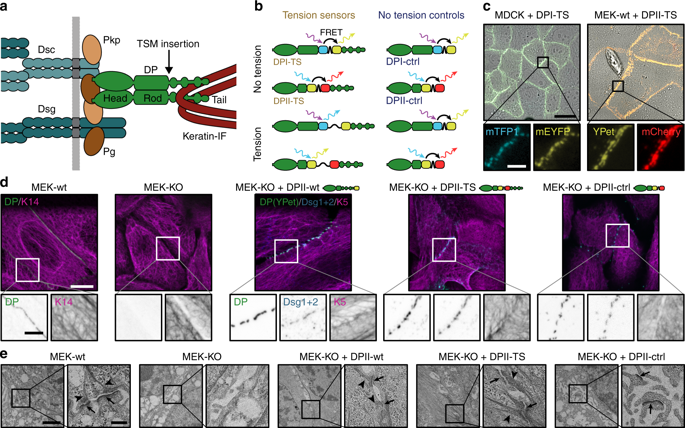当前位置:
X-MOL 学术
›
Nat. Commun.
›
论文详情
Our official English website, www.x-mol.net, welcomes your feedback! (Note: you will need to create a separate account there.)
Mechanical loading of desmosomes depends on the magnitude and orientation of external stress.
Nature Communications ( IF 16.6 ) Pub Date : 2018-12-11 , DOI: 10.1038/s41467-018-07523-0 Andrew J Price 1 , Anna-Lena Cost 2 , Hanna Ungewiß 3 , Jens Waschke 3 , Alexander R Dunn 1, 4 , Carsten Grashoff 2, 5
Nature Communications ( IF 16.6 ) Pub Date : 2018-12-11 , DOI: 10.1038/s41467-018-07523-0 Andrew J Price 1 , Anna-Lena Cost 2 , Hanna Ungewiß 3 , Jens Waschke 3 , Alexander R Dunn 1, 4 , Carsten Grashoff 2, 5
Affiliation

|
Desmosomes are intercellular adhesion complexes that connect the intermediate filament cytoskeletons of neighboring cells, and are essential for the mechanical integrity of mammalian tissues. Mutations in desmosomal proteins cause severe human pathologies including epithelial blistering and heart muscle dysfunction. However, direct evidence for their load-bearing nature is lacking. Here we develop Förster resonance energy transfer (FRET)-based tension sensors to measure the forces experienced by desmoplakin, an obligate desmosomal protein that links the desmosomal plaque to intermediate filaments. Our experiments reveal that desmoplakin does not experience significant tension under most conditions, but instead becomes mechanically loaded when cells are exposed to external mechanical stresses. Stress-induced loading of desmoplakin is transient and sensitive to the magnitude and orientation of the applied tissue deformation, consistent with a stress absorbing function for desmosomes that is distinct from previously analyzed cell adhesion complexes.
中文翻译:

桥粒的机械负荷取决于外部应力的大小和方向。
桥粒是连接相邻细胞的中间细丝细胞骨架的细胞间粘附复合物,对于哺乳动物组织的机械完整性至关重要。桥粒蛋白的突变会导致严重的人类疾病,包括上皮水疱和心肌功能障碍。但是,尚缺乏直接证明其承重性质的证据。在这里,我们开发基于Förster共振能量转移(FRET)的张力传感器,以测量desmoplakin(一种将desmosomal斑块与中间细丝相连的专一性desmosomal蛋白)所承受的力。我们的实验表明,在大多数情况下,desmoplakin不会承受明显的张力,而是当细胞暴露于外部机械应力时变为机械负载。
更新日期:2018-12-11
中文翻译:

桥粒的机械负荷取决于外部应力的大小和方向。
桥粒是连接相邻细胞的中间细丝细胞骨架的细胞间粘附复合物,对于哺乳动物组织的机械完整性至关重要。桥粒蛋白的突变会导致严重的人类疾病,包括上皮水疱和心肌功能障碍。但是,尚缺乏直接证明其承重性质的证据。在这里,我们开发基于Förster共振能量转移(FRET)的张力传感器,以测量desmoplakin(一种将desmosomal斑块与中间细丝相连的专一性desmosomal蛋白)所承受的力。我们的实验表明,在大多数情况下,desmoplakin不会承受明显的张力,而是当细胞暴露于外部机械应力时变为机械负载。



























 京公网安备 11010802027423号
京公网安备 11010802027423号